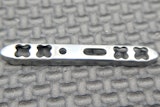Manufacturers of all types and sizes are interested in improving production processes, strengthening customer relationships, and finding talented employees. In fact, workforce related issues often sit at the top of manufacturers’ list of operational considerations, and justifiably so — the skills gap is expected to widen to 2 million jobs by 2025. According to research from Deloite and the Manufacturing Institute this gap is largely due to the retirement of baby boomers, the strength of the economy and a lack of attractiveness of the industry for new job seekers.
Understandably, many employers are looking to cobots — the smaller, cheaper, and more adaptable cousin of robots — to fill some of the shortfall. Cobots are changing the face of manufacturing, which means cobot engineers and businesses need to start thinking about how to create a more compatible relationship between human and mechanized workers. Building collaborative hybrid cobot-human teams will be essential for manufacturers moving forward.
Why do Teams Need Cobots?
Cobots are on-the-rise to becoming absolutely vital in manufacturing. While traditional robotics used to be at the forefront of manufacturers minds, now the attention has turned to cobots because of their competitive benefits. Traditional, caged-off robots for factory floors cost an average of $22,000-$37,000 per unit. These less adaptable machines take around 36-50 months to provide a return on their investment. Cobots, on the other hand, average a cost around $15,000-$30,000 per machine and have a shorter payback time of 24-48 months. While providing all the benefits of an automated machine, they are also able to integrate and collaborate with human teams.
Although big companies account for 70 percent of cobot sales and SMEs only 30 percent, some expect that this ratio will flip in the next 2-3 years. Given the plethora of tasks a cobot can be designed to perform, from making cataract lenses to assisting surgeons with precise tool movements, the integration with human production teams seems inevitable.
Will Cobots Steal Our Jobs?
The worry that intelligent robots will steal the next generations’ jobs and outclass us in manufacturing and production are at the very least premature. While cobots are certainly changing processes for small and large factories across the globe, they also operate in a sphere where human thoughts, creativity, communication and safety are vital.
Most cobots are built with force and power-limiting restrictions, along with parameters that have them slow or stop their task if a human comes close enough to be injured. The core idea behind cobots is to enable humans and machines to work alongside one other to harness the creativity and problem-solving skills of humans with the repeatability and indefatigable precision of machines.
Judgement, decision making, creativity and innovation will always be highly prized attributes in employees. Cobots are unable to provide these qualities. As such, they are only meant to augment human ability, relieving human workers from repetitive and mind-numbingly simple tasks rather than fully replacing them in the workplace.
How Cobots are Being Designed for Better Hybrid Teams
Given that cobots are intended to help humans rather than replace them, there are certain qualities engineers consider in designing a collaborative bot. Along with reducing the uncomfortable novelty of working alongside cobots, makers are concerned with designing machines humans can instrinsically understand in the same way that they understand other humans. Preemptively comprehending what a cobot is likely to do next enhances humans’ safety around them and makes collaboration more effective.
Follow the eyes to the prize: In an attempt to ease the transition of adding cobots to a human team, Rethink Robotics gave their cobots, Sawyer and Baxter, cartoon eyes. Along with adding anthropomorphic characteristics, the eyes are used to communicate to those around it what it is preparing to do next. Just as we glance at an object before we pick it up, Sawyer and Baxter glance in the direction they are about to move in. This anticipatory artificial intelligence lets people around the cobots be aware of their intention and helps build trust.
Predicting movement: Cobots are not isolated machines, moving without awareness of the environment around them as their predecessors were. Equipped with cameras and touch sensors, Dr. Shah and the team at MIT have found ways to enable cobots to track human movement in detail and learn from the information. This aids in preventing accidental human-cobot collisions which would cause tension within the teams.
Communication: While traditional robots were caged off, reliably repeating difficult and monotonous tasks on production lines, the new generation of cobots needs to be able to communicate effectively with its human team. DHL’s Locusbot pilot rollout intends to test the communicative aspect of the machines, along with testing overall versatility and warehouse navigation. The Locusbot helps staff quickly locate items within the warehouse by leading them to it and transporting the picked items back to the packers. Pickers no longer need to worry about pushing around carts and the efficiency of item retrieval is improved.
Adaptability: The other key strength required for cobots to effectively work alongside human teams is adaptability. While it is beneficial that they can be used to lift heavy parts or transport items from one area to another, to empower a workforce they must be able to adapt with them. Rethink’s solution to this issue can be seen with their cobot, Baxter, that has an easy-to-use interface proving useful for more than one reason. This interface enables a simple setup and allows human workers to collaborate more easily with the robot. Rather than requiring complex programming procedures, Baxter’s interface allows the cobot to switch between tasks by a simple reprogramming that only takes a few minutes. Human workers are also able to teach the cobot new skills by moving its arms in the necessary pattern for the new job.
The Future of Cobot Capabilities
As cobot technology develops further, engineers will search for other ways to enable machines to work closely with humans and become true partners in manufacturing processes. Some of these may include futher anthropomorphizing cobots by giving them more human capabilities and reasoning, and others may include more technical solutions to allow cobots to function more intelligently as a part of a human team. Cobot support will be necessary as they continue to streamline processes and enable future human manufacturing employees to develop into other areas and fill the more skilled and interesting roles that are already being created by the implementation of new technologies.
Ashley Little is from DO Supply, Inc., an industrial equipment supplier based in Cary, NC. She writes about robotics, machine learning, and the future of automation for industries.























